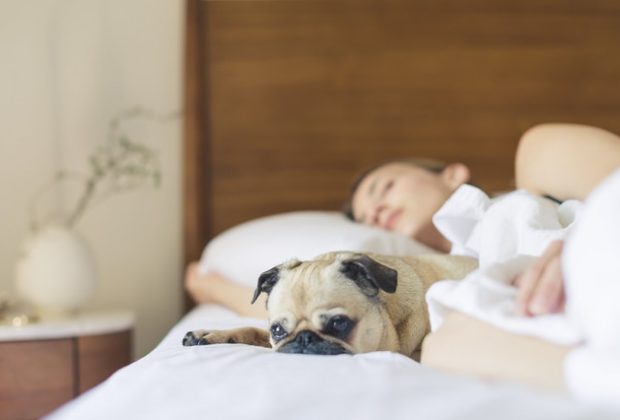What’s better than snuggling with your dog on the cushion while watching TV? Nothing comes close! They enjoy it, and as their humans, we enjoy it as well.
While you enjoy cuddling up with your pet on your couch or bed, you may sometimes wonder if it’s OK to do so. Maybe you aren’t wondering and are entirely “cool” with it like many others, but this is a pressing question for many dog owners.
So, should you let your dog on your furniture? Is it alright to let your dog sleep on that bed with you? Should they even be allowed to share your furniture in the first place?
Well, for most people, letting their canines share their beds and other furniture is an easy decision. For many others, though, as much as they love dogs, they believe in keeping dogs off of the sofa or bed for personal reasons. Some, however, believe that letting a dog on your furniture can lead to behavior issues such as aggressiveness and dominance.
Table of Contents
What Should You Do Then?
It’s all comes down to your personal preference. While letting your dog sleep on your bed or couch is unlikely to cause problems, the decision is ultimately yours. You’re the boss, and it’s your household, and it is up to you to make the rules and stick to them.
If you’re unsure of what decision to take or find it hard to take any decision at all, this article covers some details that may help you make your mind up. Before that, we’ll examine the five typical furniture restriction levels.
The Free Access
This is the most lenient and one commonly practiced by many pet owners. True, it can hardly be referred to as a “restriction” in the strict sense of the word, but it still has to be approved by every member of the family.
Luckily for most dogs, the decision to allow them to stay is almost always unanimous. It would be unfair to the dog if one family member let him on the furniture and another instructed him to leave.
Only if Invited
Dogs are allowed on the furniture only when invited to join with this rule. This leaves room for sofa cuddles without giving up leadership. However, this can sometimes be the most challenging method to enforce.
Why? You may become too engrossed in a book or a TV show. When your dog comes to snuggle next to you, you may think little of it at that point, and when you realize that you didn’t invite him later, correcting can be difficult. You’ll also end up rewarding/encouraging inappropriate behavior.
The “Get Off” Command
At any time you feel necessary, you should be able to tell your dog to leave the furniture. Your main furniture rules do not matter here. While you should not be mean about it, you should not “ask” him too. If you ask him instead of “instruct” or “tell” him, he may believe that he has the choice to decline.
On Specific Furniture
You make the rules; you can decide whether to allow your dog on specific furniture in the home or not. For example, you may choose to let him join you on the sofa but not on the bed. Teaching this is easy in a way; your pet knows that they are allowed on certain furniture and not on others. There are no crossed wires, and both the dog and the owner know the boundaries.
Never Allowed
The strictest of the five rules is also the simplest to teach after free access. You may find it hard to enforce if you have a dog that is used to being on the furniture. Other than that, you can enforce the rule easily.
With this method, you have to ensure that you enforce it, however you can. This could mean instructing him to leave when you’re around or by making the furniture hard to reach or uncomfortable. You can do this by covering them with plastic carpet runners or cartons when you’re away or when he is left unattended to.

Should You or Should You Not?
Do they get up onto your furniture when you want them to? This is one observation you should make and put into consideration before you decide on any of the five rules above. It may not be a good idea to allow your dog in bed during trigger situations such as when he is around other pets or kids or when the doorbell rings. It could cause him to assert dominance or become overbearing.
If he reacts aggressively when asked to leave the furniture, you should immediately send him down to induce obedience. Again, you don’t have to be harsh or beg; firmly tell him to move to his own bed.
If you’re yet to get him his bed, there are great outdoor beds that are skid-resistant and make the perfect, comfortable outdoor and indoor solution for your dog. It also gives the dog a space he can have for himself.
If your dog becomes angry and aggressive enough to growl, bite or snap, you may need to reconsider its furniture privileges. If talking does nothing at this point, you can take it a step further by lightly tugging the leash or sending it off with a pillow and also stopping it from coming near your bed or couch for longer intervals.
Reducing Overindulgence
Setting furniture rules can help to curb overindulgence. Sharing the same cushion or bed with you may not necessarily make your dog dominant, but behavioral problems could arise from a perceived or apparent lack of leadership. And a piece of furniture can be a valuable resource, and authority often involves resource control.
Restricting your dog’s furniture use reduces overindulgence resulting in excessive affection that can easily exaggerate their status.
Visitations
Before making and sticking with your pet’s furniture rules, this is one area to consider. If your dog is ever a guest in someone else’s home, understand that not everyone likes dogs on their furniture.
You may be comfortable with it, but your guest may not be pleased with a dog running over his couch or bed. If they do not, it should come as no surprise when they request that you leave Fido home the next time you arrange to visit.
Health and Safety Issues
Most dogs shed, and many don’t do this lightly. This is why many pet owners prefer keeping their dogs off all furniture. Aside from hair, you also have grime, debris, and dirt to worry about, and a lot of pet owners are concerned about the potential for the easy spread of diseases.
Plus, there are more than a handful of diseases considered zoonotic. That is, they can be transmitted from animals to humans. These include parasitic and fungal infections; however, the risk is significantly reduced if your dog remains healthy.
Health, Vet Visits, and Your Dog
To ensure that your dog stays as healthy as possible, visit the vet at least once every 12 months for routine checkups. It doesn’t matter whether you let him on your furniture.
A vaccinated and well-cared-for dog is usually free of fleas and parasites. The first signs of these conditions are usually treated as soon as they are discovered.
You can also do your part in minimizing the germs and debris your pet brings in by thoroughly wiping its paws and regular grooming. Aside from regular baths, you should ensure it is bathed as needed and also trim the nails regularly to reduce or eliminate the possibility of damage from the claws.
Final words
If you're restricting your dog from the furniture, make sure it has no access to them while you're away. One way to ensure that it truly stays away from furniture is by providing an alternative. This is where a dog crate or dog bed becomes highly important. A crate offers a solution to keep your dog away from the furniture when you're not home.
If you have successfully trained your dog to understand that its stay on the furniture is conditional or that it is allowed on them at all times, try to make sure he earns it.
Remember, staying on your furniture should be considered as a privilege for your dog, not a right. This isn't just a question of him asserting dominance; it is also about learning acceptable behaviors. If he oversteps this privilege, he needs to be told to leave the furniture but be consistent and firm, or your dog may never fully grasp your expectations of him.
It is also fine if your dog has to stay away from the furniture as a general household rule for hygiene purposes or to minimize damages. Your dog should have no problem with that as long as he has his spot in the home to go to whenever he wants.
Finally, you want to make sure that everyone in your home enforces the rule. As said earlier, it would be unfair and confusing to your dog if one family member lets him sit with him on furniture and another tells him to leave when he tries to share these spaces with them.
About the Author
Kirsten Heggarty
Kirsten created The Pet Handbook with the aim of sharing her knowledge about pets, pet food, healthy habits, and more. All of her advice is based on years of her own experience with her pets, and feedback that she has received from grateful readers about her tips. If you want to know more please read the About Me page.









